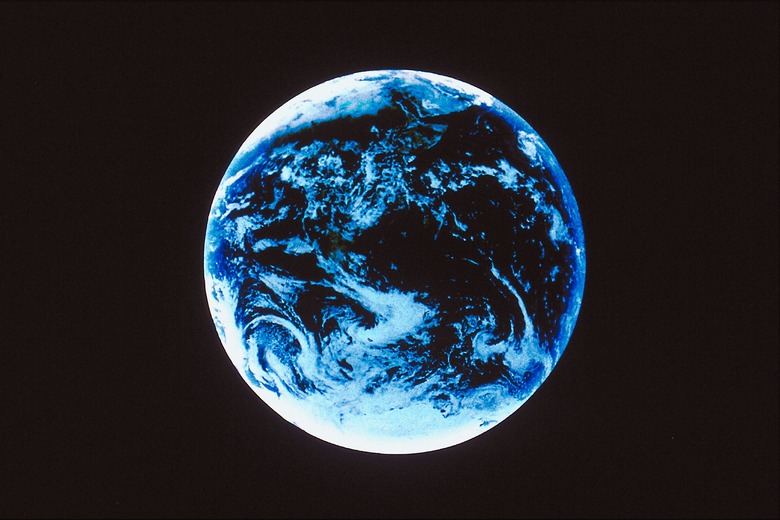Earth's First Atmosphere Contained What Gases?
As the solar system's debris coalesced into the planets now circling the Sun, most of the lightest gases formed a brief, thin atmosphere around the spinning ball of rocks that became the Earth.
Since then, the atmosphere has changed, and it continues to adjust to life. Earth's systems remain as dynamic today as they were during that early Earth history.
Earth's Earliest Atmosphere
Earth's Earliest Atmosphere
Earth's earliest atmosphere predates or perhaps coincides with the final accumulation of material that now forms the planet. Hydrogen, helium and hydrogen-containing compounds briefly surrounded the forming Earth.
Part of these light gases, leftovers from the Sun, escaped Earth's gravity. Earth hadn't yet developed its iron core, so with no protective magnetic field, the Sun's powerful solar wind blew away the light elements surrounding the proto-Earth.
Earth's Second Atmosphere
Earth's Second Atmosphere
The second layer of gases that surrounded Earth could arguably be called Earth's first "real" atmosphere. The spinning ball of molten material developed from debris of the forming solar system bubbled and churned. Radioactive decay, friction and residual heat kept the Earth in a molten state for half a billion years.
During that time, density differences caused the Earth's heavier elements to sink toward Earth's developing core and lighter elements to rise toward the surface. Volcanic eruptions released gases, and the formation of atmosphere began.
Earth's atmosphere formed from the gases released by the constant volcanic activity. The gas mixture would have been much like the composition released during modern volcanic eruptions. These gases include:
- Water vapor
- Carbon dioxide
- Sulfur dioxide
- Hydrogen sulfide
- Carbon monoxide
- Sulfur
- Chlorine
- Nitrogen
- Nitrogen compounds like ammonia, hydrogen and methane
The lack of rust in early iron-rich rocks shows there was no free oxygen among the gases in Earth's early atmosphere.
As the Earth cooled and gases accumulated, the water vapor eventually began to condense into thick clouds, and the rains began. This rain continued for millions of years, eventually forming the Earth's first ocean. The ocean has ever since been an integral part of the history of the atmosphere.
Earth's Third Formation of Atmosphere
Earth's Third Formation of Atmosphere
When we compare Earth's early atmosphere with its present one, major differences are obvious. But the change from a reducing atmosphere, poisonous to most modern life forms, to the current oxygen-rich atmosphere took about 2 billion years, almost half of Earth's lifespan.
Fossil evidence shows that the earliest life forms on Earth were bacteria. Cyanobacteria, which are bacteria capable of photosynthesis, and chemosynthetic bacteria found at deep sea vents thrive in an oxygen-depleted atmosphere.
These types of bacteria could thrive in Earth's second atmosphere. Evidence shows they did thrive for a long time, happily converting carbon dioxide into food and releasing oxygen as a waste product.
At first the oxygen combined with iron-rich rocks, forming the first rust in the rock record. But eventually the oxygen released exceeded nature's ability to compensate. The cyanobacteria gradually polluted their environment with oxygen and caused Earth's current atmosphere to develop.
While the cyanobacteria were churning out oxygen, sunlight was breaking down the ammonia in the atmosphere. Ammonia decomposes into nitrogen and hydrogen. The nitrogen gradually built up in the atmosphere, but the hydrogen, like Earth's first atmosphere, gradually escaped into space.
Earth's Current Atmosphere
Earth's Current Atmosphere
About 2 billion years ago, the transition from the volcanic gas atmosphere to the current nitrogen-oxygen atmosphere occurred. The oxygen-carbon dioxide ratio has fluctuated during the past, reaching an oxygen-rich high of about 35 percent during the Carboniferous Period (300-355 million years ago) and an oxygen low of about 15 percent near the end of the Permian Period (250 million years ago).
The modern atmosphere contains about 78 percent nitrogen, 21 percent oxygen, 0.9 percent argon and 0.1 percent other gases, including water vapor and carbon dioxide. This ratio, with some fluctuations of the oxygen-carbon dioxide ratio, has allowed the development of life on Earth.
Conversely, the interactions between photosynthesizing plants and respiring animals maintain the current atmospheric ratio of gases.
References
- Eastern Illinois University: Origin of the Earth's Atmosphere
- University of Michigan: Evolution of the Atmosphere: Composition, Structure and Energy
- Smithsonian Environmental Research Center: The Earliest Atmosphere
- NOAA SciJinks: How Did Earth's Atmosphere Form?
- Encyclopaedia Britannica: Evolution of the Atmosphere
Cite This Article
MLA
Blaettler, Karen G. "Earth's First Atmosphere Contained What Gases?" sciencing.com, https://www.sciencing.com/earths-first-atmosphere-contained-gases-2034/. 31 July 2019.
APA
Blaettler, Karen G. (2019, July 31). Earth's First Atmosphere Contained What Gases?. sciencing.com. Retrieved from https://www.sciencing.com/earths-first-atmosphere-contained-gases-2034/
Chicago
Blaettler, Karen G. Earth's First Atmosphere Contained What Gases? last modified March 24, 2022. https://www.sciencing.com/earths-first-atmosphere-contained-gases-2034/
